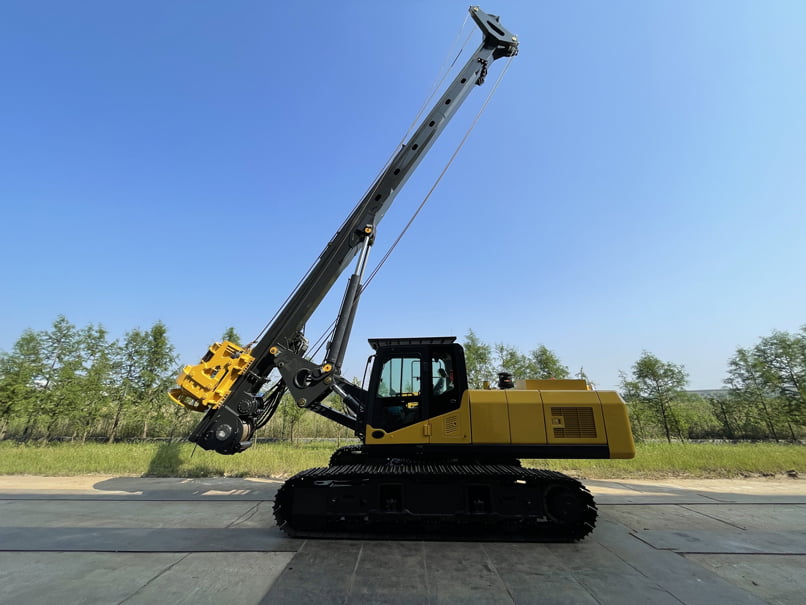مقدمة
Hydraulic rotary drilling rigs have become indispensable tools for modern infrastructure projects around the world. These complex machines utilize hydraulic power and rotary drilling techniques to efficiently bore holes deep underground for applications like foundation installation, utility installation, geotechnical exploration, and more. As infrastructure needs continue growing to support expanding populations and economies, hydraulic rotary drilling rigs are playing a vital role in enabling this progress. This blog post will explore how these rigs are shaping infrastructure development through their capabilities and widespread use on construction sites.
Capabilities of Hydraulic Rotary

Drilling Rigs Hydraulic rotary drilling rigs offer several key capabilities that make them well-suited for infrastructure projects:
- Power and Torque: Hydraulic systems provide powerful rotational force to turn drilling tools and break up subsurface formations. This allows rigs to drill holes ranging from small diameter test holes to large diameter foundation holes.
- Flexibility: Rigs can be configured with different mast heights, drilling tool sizes, and accessory equipment to handle a variety of drilling applications. Their modular design also allows for transport between job sites.
- Efficiency: Hydraulic power combined with rotary drilling methods allow rigs to drill holes much faster than alternative techniques like cable tool or auger drilling. This improves productivity and reduces project timelines.
- Precision: Electronic control systems and instrumentation onboard modern rigs provide accurate depth and torque readings to operators. This ensures holes meet precise design specifications.
- Safety: Safety features like mast-fall prevention systems, emergency shutdown controls, and fall protection help protect rig operators from hazards. Enclosed cabs also shield operators from dust and noise.
Applications in Infrastructure Projects
The versatility of hydraulic rotary drilling rigs makes them widely applicable across different types of infrastructure projects. Some key uses are highlighted below:
| Application | وصف |
|---|---|
| Foundation Installation | Drilling piling or caisson holes for building, bridge, and tower foundations. |
| Utility Installation | Boring underground for pipelines, cables, and other utilities to be placed beneath roads, railways, and other structures. |
| Geotechnical Exploration | Taking soil samples and performing in-situ testing to evaluate subsurface conditions for engineering design. |
| Dewatering | Installing deep wells to remove and control groundwater during construction in wet soil conditions. |
| Anchoring | Drilling anchor holes for retaining walls, earth anchors, and soil nail walls used in slope stabilization. |
As shown, their ability to efficiently drill a variety of hole sizes and depths in different ground conditions and applications is driving their widespread use in infrastructure development.
Enabling Megaprojects

Around the World Large-scale infrastructure projects like high-speed rail lines, tunnels, dams, and metro systems require huge numbers of foundation elements and underground utilities to be installed. Hydraulic rotary drilling rigs are playing a critical role in realizing these megaprojects by rapidly drilling the thousands or even millions of holes needed. Here are a few examples:
- California High-Speed Rail: Over 300 rigs were used to drill over 500,000 holes for foundations, shafts, and tunnels along the first 500 km segment.
- Delhi Metro Rail: Rigs drilled over 20,000 piles to support viaducts and stations across the expanding metro network.
- Panama Canal Expansion: Rigs drilled over 750,000 m of foundation and drainage holes during the $5.25 billion project to accommodate larger ships.
- Gotthard Base Tunnel: Specialized rigs drilled over 15,000 m of pilot holes through the Alps for the 57 km railway tunnel.
As infrastructure needs continue growing globally to support economic and population growth, hydraulic rotary drilling rigs will remain essential tools for completing megaprojects on aggressive schedules. Their drilling productivity is literally helping to drive progress worldwide.
Conclusion: hydraulic rotary drilling rig
In conclusion, hydraulic rotary drilling rigs have become indispensable equipment for modern infrastructure projects due to their powerful drilling capabilities. Their versatility and productivity are enabling megaprojects around the world that are developing and expanding transportation, energy, and urban infrastructure. As infrastructure needs continue growing globally to support expanding populations and economies, these rigs will remain at the forefront of driving progress by rapidly installing foundations, utilities, and other underground elements. Their widespread and growing use underscores how integral they have become for shaping infrastructure development.
الأسئلة الشائعة
Q: What is the typical process for drilling a hole with these rigs?
A: Holes are drilled by attaching a drill bit to the rotary head, lowering it into the ground, and applying rotational force and downward pressure to bore through soil/rock layers. Water or drilling mud is used to flush cuttings from the hole and cool/lubricate the bit. Rigs can drill continuous core samples or temporary casing/anchored holes.
Q: How deep can hydraulic rotary drilling rigs drill?
A: Depth capacity depends on rig size and configuration but can range from just a few meters for small test holes up to 500 m or more for large production rigs. Specialized rigs can drill to depths of over 1,000 m for applications like mine shafts and geothermal wells.
Q: What types of drill bits and tools can they use?
A: Common bits include tri-cone roller bits for soil/rock, diamond core bits, drag bits, bucket augers, casing oscillators, and specialty bits. Ancillary tools include sampling tubes, casing, downhole hammers, and more depending on the application.
Q: What are some common manufacturers of these rigs?
A: Major global manufacturers include Soilmec, Casagrande, Liebherr, Sandvik, Atlas Copco, Caterpillar, and many others. Chinese brands like XCMG and Sany are also increasingly common in Asian markets.






-150x150.webp)
